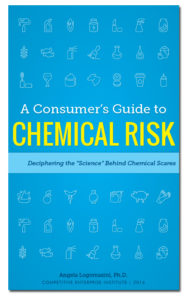The nation’s obesity problem has given new impetus and spin to the endocrine disrupter theory. To boot, researchers misuse the field of “epigenetics,” which involves the study of how environmental factors—i.e., factors other than DNA—can influence how genes express themselves and how those changes can be passed down from one generation to the next. For example, a person’s diet or even stress levels may influence gene expression and those traits may be inheritable.
It is not yet clear how trace exposure to synthetic chemicals might impact gene expression, and some researchers are drawing conclusions too quickly. Generating headlines and perhaps potential funding, some researchers have gone as far as coining the buzzword “obseogens,” which is more akin to marketing phraseology than scientific terminology. Allegedly, these so-called obseogens include endocrine disrupters that not only affect our health by changing our hormone levels today; they change our gene expression in ways that make future generations more prone to obesity.(1)
The obesogens theory is highly speculative with the underlying research suffering from many confounding factors and limitations,(2) and results have not been reproducible.(3) But using loaded phraseology, researchers have been able to capture provocative headlines among a wide range of sources from mommy blogs(4) to The Atlantic,(5) building momentum for their research efforts. As a result, many consumers may now believe that they are basically pre-programed to become fat, discouraging them from taking positive action to prevent or reverse obesity. Some may even focus on following the foolish “Non-Obesogen Diet Plan,” as New York Times columnist Nicolas Kristof calls it, rather than addressing real issues related to overeating.(6) Meanwhile, there is a far more compelling body of evidence that obesity is related to over eating and lack of exercise.(7)
Unfortunately, in addition to misdirecting consumers about how they can address obesity, this kind of framing fosters the outrageous, generating headlines like: “The Chemicals Behind the Shrinking of Boys Genitals.”(8) Never mind the fact that there isn’t a compelling body of evidence to support this theory.
Browse the terms on the sidebar of this webpage for more details and/or download a copy of A Consumer’s Guide to Chemical Risk: Deciphering the “Science” Behind Chemical Scares.
(1) See Angela Logomasini, “What will Really Make us Fat in the New Year,” FOX News, December 29, 2010.
(2) Richard M. Sharpe and Amanda J. Drake, “Obesogens and Obesity—an Alternative,” Obesity 21 (2013): 1081-1083.
(3) News Bureau, University of Missouri, “Previous Studies on Toxic Effects of BPA Couldn’t be Reproduced, says MU Research Team,” January 02, 2013.
(4)Rachel Sarnoff, “3 Tips to Avoid Obesogens—And Obesity,” Mommy Greenest (blog), July 25, 2013.
(5) Kristin Wartman, “What’s Really Making Us Fat?” The Atlantic, March 8 2012.
(6) Nicholas D. Kristof, “The All-New Non-Obesogen Diet Plan!, New York Times Blog, January 19, 2013.
(7) For example, see Lisa R. Young and Marion Nestle, “The Contribution of Expanding Portion Sizes to the US Obesity Epidemic,” American Journal of Public Health 92, no 2 (February 2002): 246–249.
(8) Dr. Mercola, “The Chemicals Behind the Shirking of Boy’s Genitals, Food Consumer,” September 1, 2013.


